A Report on Customer Perspectives on Transport for London Services
VerifiedAdded on 2024/06/05
|26
|6797
|411
Report
AI Summary
This report investigates customer perspectives on Transport for London (TFL) services, aiming to understand customer satisfaction levels, evaluate approaches taken by TFL to meet customer needs, and identify issues faced by customers. The report includes a literature review of the UK transport industry, focusing on customer issues and satisfaction, and the measures taken to improve services. The methodology section details the philosophical underpinnings, research methods, sampling, data collection, and analysis techniques used, as well as ethical considerations and research limitations. The findings and discussion section presents both quantitative and qualitative analysis of customer feedback. The report concludes with recommendations for TFL to mitigate identified issues and enhance customer satisfaction. This document is available on Desklib, a platform offering study tools and resources for students.
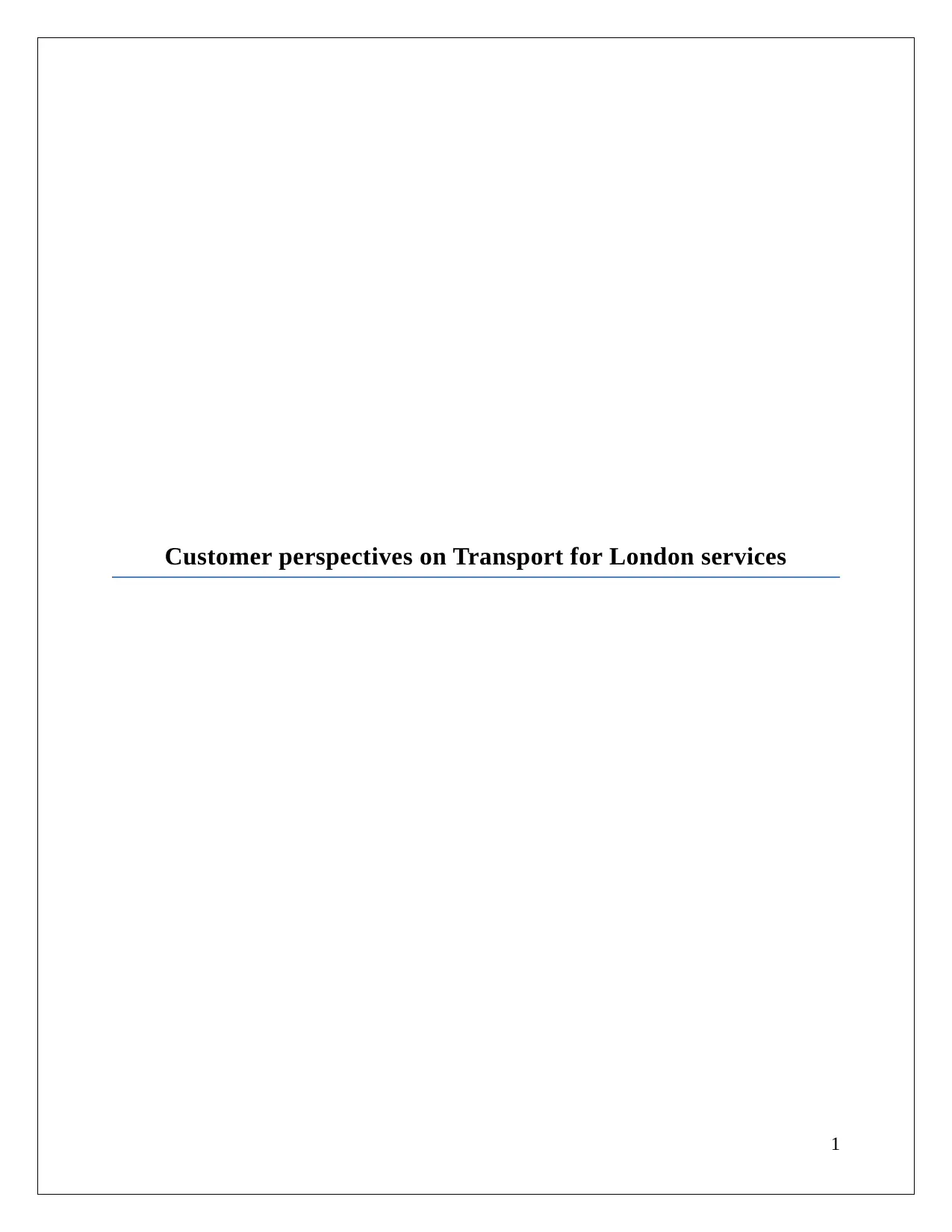
Customer perspectives on Transport for London services
1
1
Paraphrase This Document
Need a fresh take? Get an instant paraphrase of this document with our AI Paraphraser
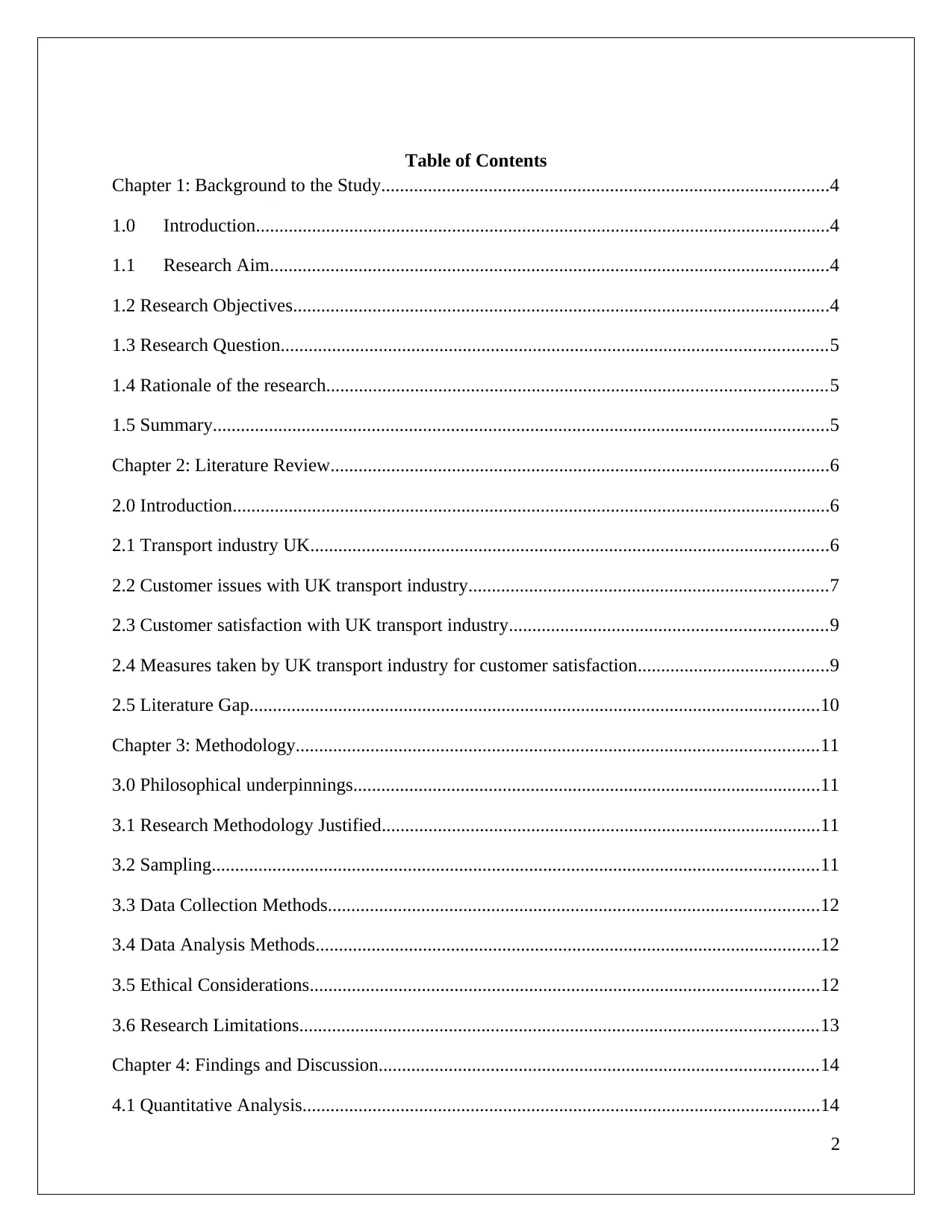
Table of Contents
Chapter 1: Background to the Study................................................................................................4
1.0 Introduction...........................................................................................................................4
1.1 Research Aim........................................................................................................................4
1.2 Research Objectives...................................................................................................................4
1.3 Research Question.....................................................................................................................5
1.4 Rationale of the research...........................................................................................................5
1.5 Summary....................................................................................................................................5
Chapter 2: Literature Review...........................................................................................................6
2.0 Introduction................................................................................................................................6
2.1 Transport industry UK...............................................................................................................6
2.2 Customer issues with UK transport industry.............................................................................7
2.3 Customer satisfaction with UK transport industry....................................................................9
2.4 Measures taken by UK transport industry for customer satisfaction.........................................9
2.5 Literature Gap..........................................................................................................................10
Chapter 3: Methodology................................................................................................................11
3.0 Philosophical underpinnings....................................................................................................11
3.1 Research Methodology Justified..............................................................................................11
3.2 Sampling..................................................................................................................................11
3.3 Data Collection Methods.........................................................................................................12
3.4 Data Analysis Methods............................................................................................................12
3.5 Ethical Considerations.............................................................................................................12
3.6 Research Limitations...............................................................................................................13
Chapter 4: Findings and Discussion..............................................................................................14
4.1 Quantitative Analysis...............................................................................................................14
2
Chapter 1: Background to the Study................................................................................................4
1.0 Introduction...........................................................................................................................4
1.1 Research Aim........................................................................................................................4
1.2 Research Objectives...................................................................................................................4
1.3 Research Question.....................................................................................................................5
1.4 Rationale of the research...........................................................................................................5
1.5 Summary....................................................................................................................................5
Chapter 2: Literature Review...........................................................................................................6
2.0 Introduction................................................................................................................................6
2.1 Transport industry UK...............................................................................................................6
2.2 Customer issues with UK transport industry.............................................................................7
2.3 Customer satisfaction with UK transport industry....................................................................9
2.4 Measures taken by UK transport industry for customer satisfaction.........................................9
2.5 Literature Gap..........................................................................................................................10
Chapter 3: Methodology................................................................................................................11
3.0 Philosophical underpinnings....................................................................................................11
3.1 Research Methodology Justified..............................................................................................11
3.2 Sampling..................................................................................................................................11
3.3 Data Collection Methods.........................................................................................................12
3.4 Data Analysis Methods............................................................................................................12
3.5 Ethical Considerations.............................................................................................................12
3.6 Research Limitations...............................................................................................................13
Chapter 4: Findings and Discussion..............................................................................................14
4.1 Quantitative Analysis...............................................................................................................14
2
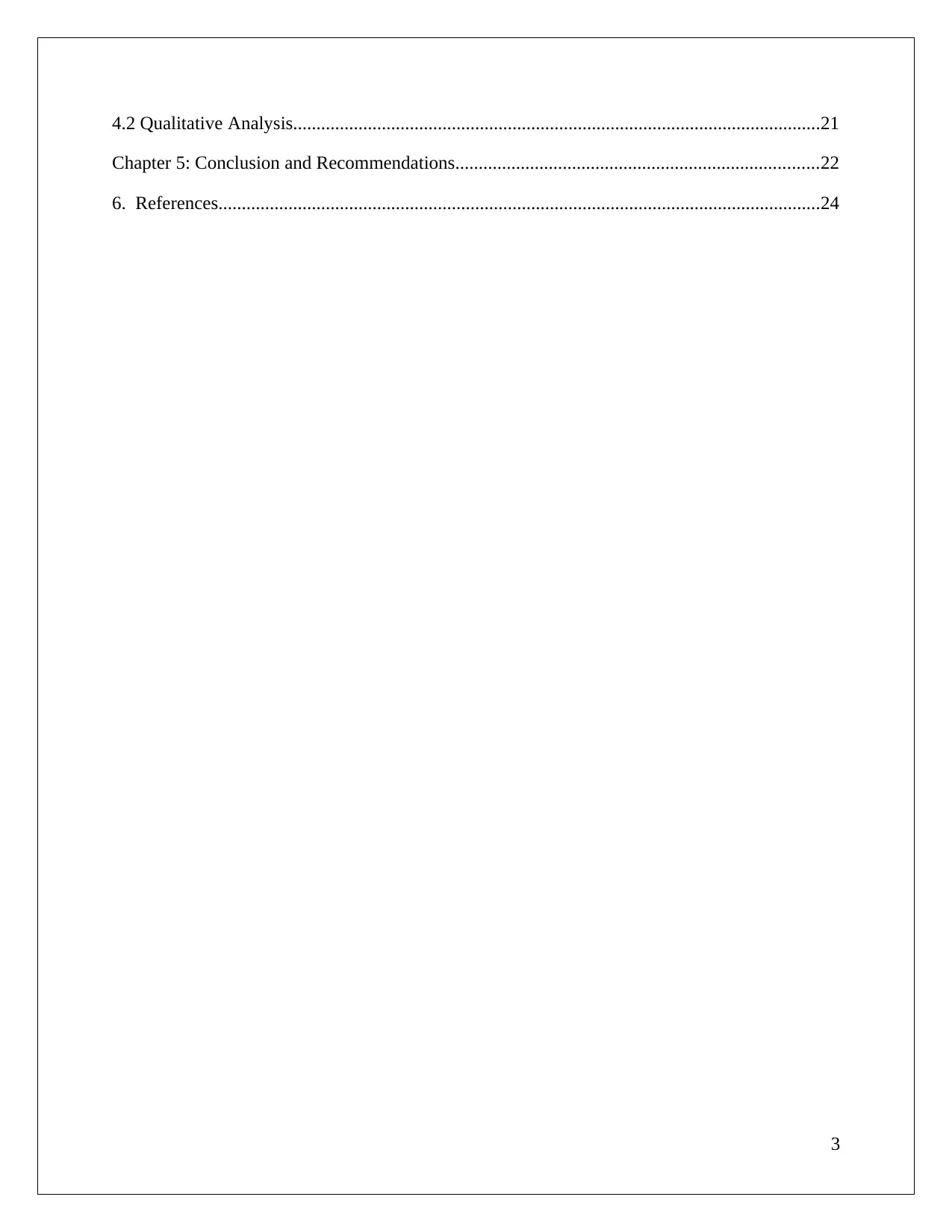
4.2 Qualitative Analysis.................................................................................................................21
Chapter 5: Conclusion and Recommendations..............................................................................22
6. References.................................................................................................................................24
3
Chapter 5: Conclusion and Recommendations..............................................................................22
6. References.................................................................................................................................24
3
⊘ This is a preview!⊘
Do you want full access?
Subscribe today to unlock all pages.

Trusted by 1+ million students worldwide
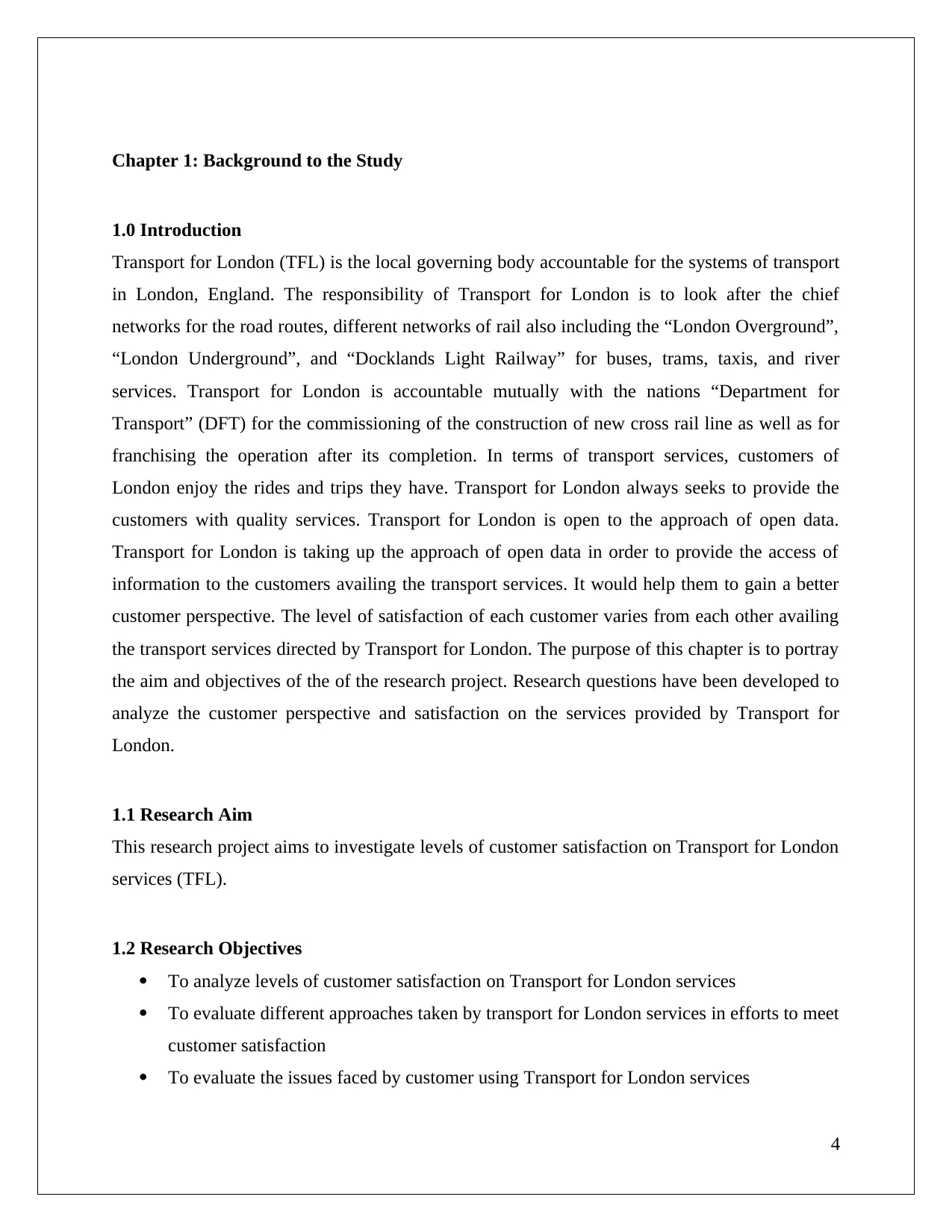
Chapter 1: Background to the Study
1.0 Introduction
Transport for London (TFL) is the local governing body accountable for the systems of transport
in London, England. The responsibility of Transport for London is to look after the chief
networks for the road routes, different networks of rail also including the “London Overground”,
“London Underground”, and “Docklands Light Railway” for buses, trams, taxis, and river
services. Transport for London is accountable mutually with the nations “Department for
Transport” (DFT) for the commissioning of the construction of new cross rail line as well as for
franchising the operation after its completion. In terms of transport services, customers of
London enjoy the rides and trips they have. Transport for London always seeks to provide the
customers with quality services. Transport for London is open to the approach of open data.
Transport for London is taking up the approach of open data in order to provide the access of
information to the customers availing the transport services. It would help them to gain a better
customer perspective. The level of satisfaction of each customer varies from each other availing
the transport services directed by Transport for London. The purpose of this chapter is to portray
the aim and objectives of the of the research project. Research questions have been developed to
analyze the customer perspective and satisfaction on the services provided by Transport for
London.
1.1 Research Aim
This research project aims to investigate levels of customer satisfaction on Transport for London
services (TFL).
1.2 Research Objectives
To analyze levels of customer satisfaction on Transport for London services
To evaluate different approaches taken by transport for London services in efforts to meet
customer satisfaction
To evaluate the issues faced by customer using Transport for London services
4
1.0 Introduction
Transport for London (TFL) is the local governing body accountable for the systems of transport
in London, England. The responsibility of Transport for London is to look after the chief
networks for the road routes, different networks of rail also including the “London Overground”,
“London Underground”, and “Docklands Light Railway” for buses, trams, taxis, and river
services. Transport for London is accountable mutually with the nations “Department for
Transport” (DFT) for the commissioning of the construction of new cross rail line as well as for
franchising the operation after its completion. In terms of transport services, customers of
London enjoy the rides and trips they have. Transport for London always seeks to provide the
customers with quality services. Transport for London is open to the approach of open data.
Transport for London is taking up the approach of open data in order to provide the access of
information to the customers availing the transport services. It would help them to gain a better
customer perspective. The level of satisfaction of each customer varies from each other availing
the transport services directed by Transport for London. The purpose of this chapter is to portray
the aim and objectives of the of the research project. Research questions have been developed to
analyze the customer perspective and satisfaction on the services provided by Transport for
London.
1.1 Research Aim
This research project aims to investigate levels of customer satisfaction on Transport for London
services (TFL).
1.2 Research Objectives
To analyze levels of customer satisfaction on Transport for London services
To evaluate different approaches taken by transport for London services in efforts to meet
customer satisfaction
To evaluate the issues faced by customer using Transport for London services
4
Paraphrase This Document
Need a fresh take? Get an instant paraphrase of this document with our AI Paraphraser
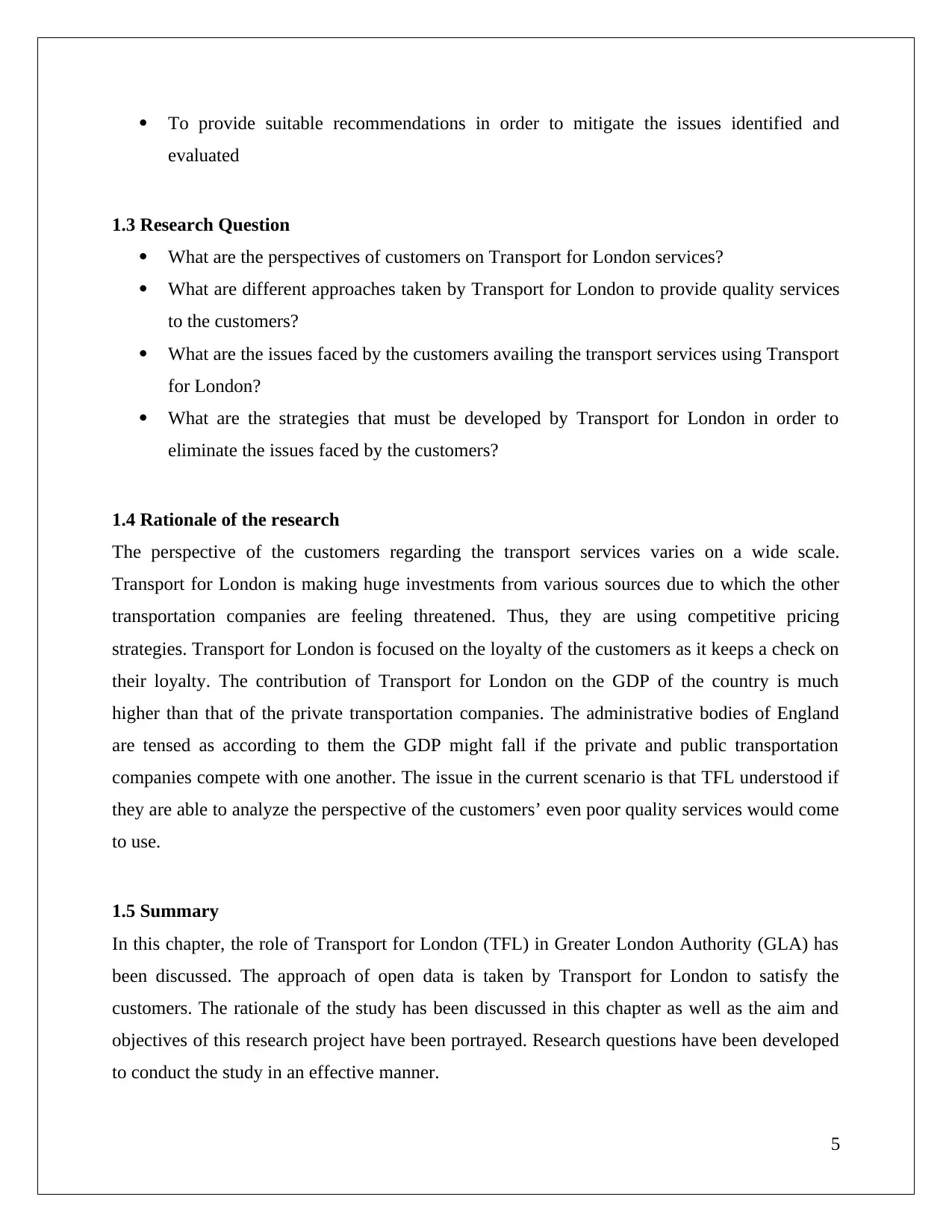
To provide suitable recommendations in order to mitigate the issues identified and
evaluated
1.3 Research Question
What are the perspectives of customers on Transport for London services?
What are different approaches taken by Transport for London to provide quality services
to the customers?
What are the issues faced by the customers availing the transport services using Transport
for London?
What are the strategies that must be developed by Transport for London in order to
eliminate the issues faced by the customers?
1.4 Rationale of the research
The perspective of the customers regarding the transport services varies on a wide scale.
Transport for London is making huge investments from various sources due to which the other
transportation companies are feeling threatened. Thus, they are using competitive pricing
strategies. Transport for London is focused on the loyalty of the customers as it keeps a check on
their loyalty. The contribution of Transport for London on the GDP of the country is much
higher than that of the private transportation companies. The administrative bodies of England
are tensed as according to them the GDP might fall if the private and public transportation
companies compete with one another. The issue in the current scenario is that TFL understood if
they are able to analyze the perspective of the customers’ even poor quality services would come
to use.
1.5 Summary
In this chapter, the role of Transport for London (TFL) in Greater London Authority (GLA) has
been discussed. The approach of open data is taken by Transport for London to satisfy the
customers. The rationale of the study has been discussed in this chapter as well as the aim and
objectives of this research project have been portrayed. Research questions have been developed
to conduct the study in an effective manner.
5
evaluated
1.3 Research Question
What are the perspectives of customers on Transport for London services?
What are different approaches taken by Transport for London to provide quality services
to the customers?
What are the issues faced by the customers availing the transport services using Transport
for London?
What are the strategies that must be developed by Transport for London in order to
eliminate the issues faced by the customers?
1.4 Rationale of the research
The perspective of the customers regarding the transport services varies on a wide scale.
Transport for London is making huge investments from various sources due to which the other
transportation companies are feeling threatened. Thus, they are using competitive pricing
strategies. Transport for London is focused on the loyalty of the customers as it keeps a check on
their loyalty. The contribution of Transport for London on the GDP of the country is much
higher than that of the private transportation companies. The administrative bodies of England
are tensed as according to them the GDP might fall if the private and public transportation
companies compete with one another. The issue in the current scenario is that TFL understood if
they are able to analyze the perspective of the customers’ even poor quality services would come
to use.
1.5 Summary
In this chapter, the role of Transport for London (TFL) in Greater London Authority (GLA) has
been discussed. The approach of open data is taken by Transport for London to satisfy the
customers. The rationale of the study has been discussed in this chapter as well as the aim and
objectives of this research project have been portrayed. Research questions have been developed
to conduct the study in an effective manner.
5
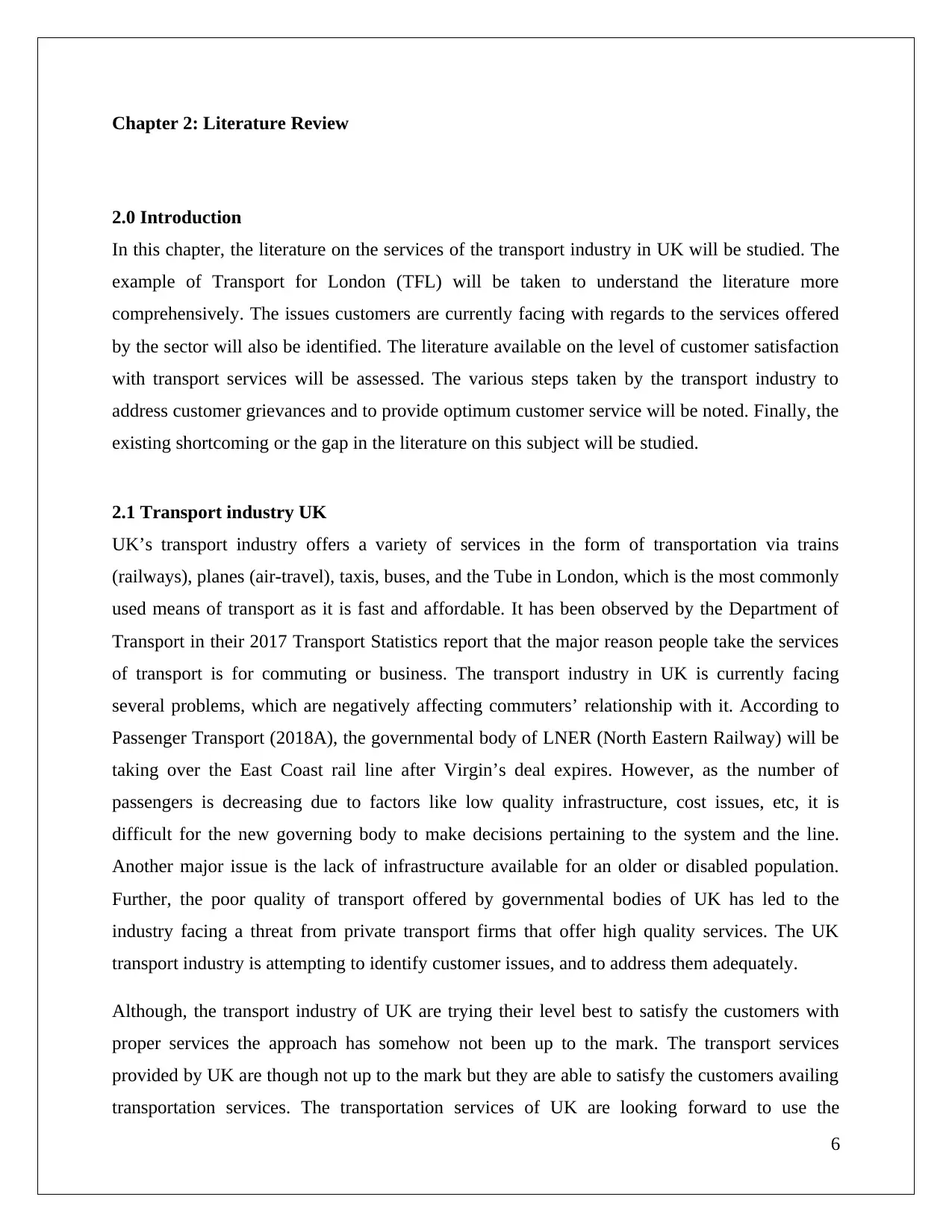
Chapter 2: Literature Review
2.0 Introduction
In this chapter, the literature on the services of the transport industry in UK will be studied. The
example of Transport for London (TFL) will be taken to understand the literature more
comprehensively. The issues customers are currently facing with regards to the services offered
by the sector will also be identified. The literature available on the level of customer satisfaction
with transport services will be assessed. The various steps taken by the transport industry to
address customer grievances and to provide optimum customer service will be noted. Finally, the
existing shortcoming or the gap in the literature on this subject will be studied.
2.1 Transport industry UK
UK’s transport industry offers a variety of services in the form of transportation via trains
(railways), planes (air-travel), taxis, buses, and the Tube in London, which is the most commonly
used means of transport as it is fast and affordable. It has been observed by the Department of
Transport in their 2017 Transport Statistics report that the major reason people take the services
of transport is for commuting or business. The transport industry in UK is currently facing
several problems, which are negatively affecting commuters’ relationship with it. According to
Passenger Transport (2018A), the governmental body of LNER (North Eastern Railway) will be
taking over the East Coast rail line after Virgin’s deal expires. However, as the number of
passengers is decreasing due to factors like low quality infrastructure, cost issues, etc, it is
difficult for the new governing body to make decisions pertaining to the system and the line.
Another major issue is the lack of infrastructure available for an older or disabled population.
Further, the poor quality of transport offered by governmental bodies of UK has led to the
industry facing a threat from private transport firms that offer high quality services. The UK
transport industry is attempting to identify customer issues, and to address them adequately.
Although, the transport industry of UK are trying their level best to satisfy the customers with
proper services the approach has somehow not been up to the mark. The transport services
provided by UK are though not up to the mark but they are able to satisfy the customers availing
transportation services. The transportation services of UK are looking forward to use the
6
2.0 Introduction
In this chapter, the literature on the services of the transport industry in UK will be studied. The
example of Transport for London (TFL) will be taken to understand the literature more
comprehensively. The issues customers are currently facing with regards to the services offered
by the sector will also be identified. The literature available on the level of customer satisfaction
with transport services will be assessed. The various steps taken by the transport industry to
address customer grievances and to provide optimum customer service will be noted. Finally, the
existing shortcoming or the gap in the literature on this subject will be studied.
2.1 Transport industry UK
UK’s transport industry offers a variety of services in the form of transportation via trains
(railways), planes (air-travel), taxis, buses, and the Tube in London, which is the most commonly
used means of transport as it is fast and affordable. It has been observed by the Department of
Transport in their 2017 Transport Statistics report that the major reason people take the services
of transport is for commuting or business. The transport industry in UK is currently facing
several problems, which are negatively affecting commuters’ relationship with it. According to
Passenger Transport (2018A), the governmental body of LNER (North Eastern Railway) will be
taking over the East Coast rail line after Virgin’s deal expires. However, as the number of
passengers is decreasing due to factors like low quality infrastructure, cost issues, etc, it is
difficult for the new governing body to make decisions pertaining to the system and the line.
Another major issue is the lack of infrastructure available for an older or disabled population.
Further, the poor quality of transport offered by governmental bodies of UK has led to the
industry facing a threat from private transport firms that offer high quality services. The UK
transport industry is attempting to identify customer issues, and to address them adequately.
Although, the transport industry of UK are trying their level best to satisfy the customers with
proper services the approach has somehow not been up to the mark. The transport services
provided by UK are though not up to the mark but they are able to satisfy the customers availing
transportation services. The transportation services of UK are looking forward to use the
6
⊘ This is a preview!⊘
Do you want full access?
Subscribe today to unlock all pages.

Trusted by 1+ million students worldwide
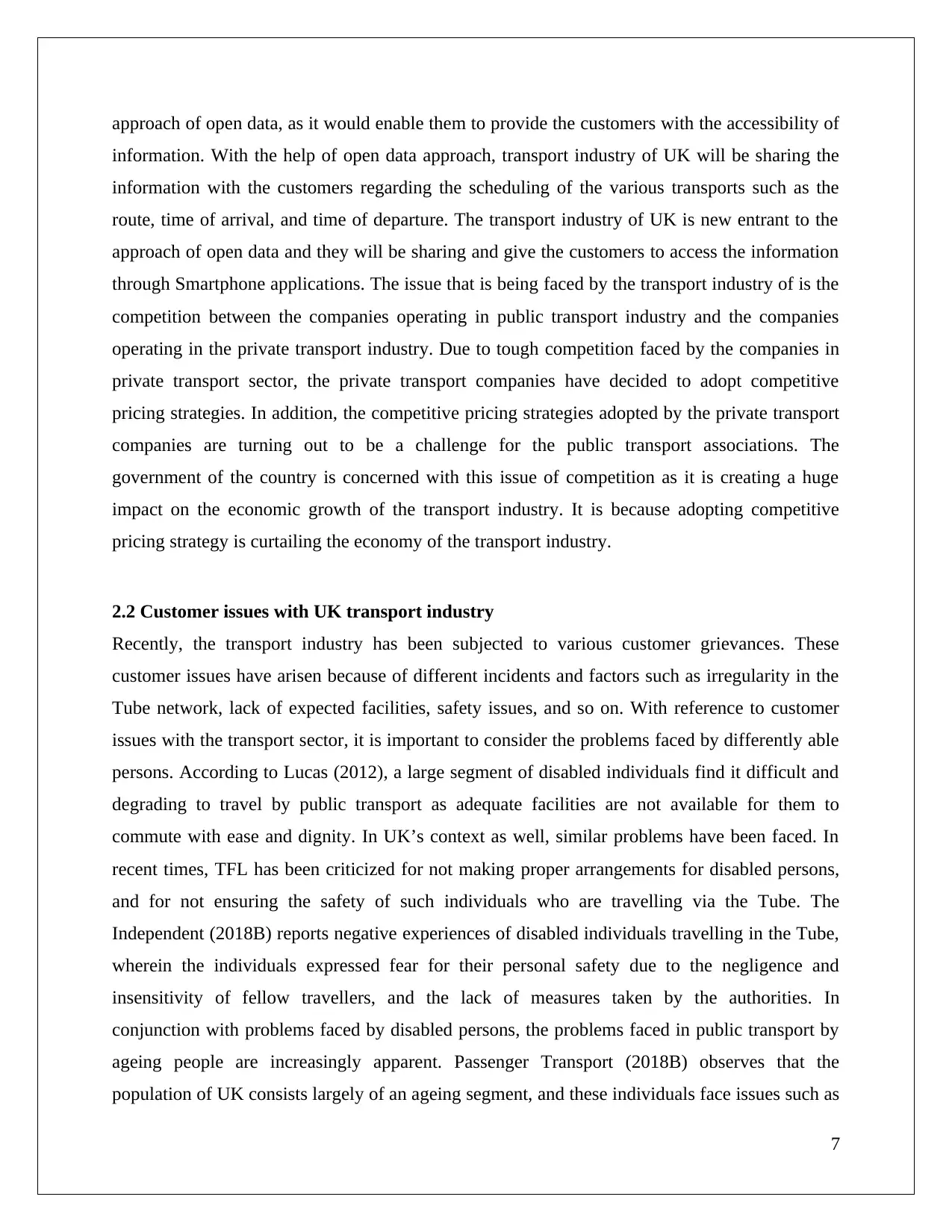
approach of open data, as it would enable them to provide the customers with the accessibility of
information. With the help of open data approach, transport industry of UK will be sharing the
information with the customers regarding the scheduling of the various transports such as the
route, time of arrival, and time of departure. The transport industry of UK is new entrant to the
approach of open data and they will be sharing and give the customers to access the information
through Smartphone applications. The issue that is being faced by the transport industry of is the
competition between the companies operating in public transport industry and the companies
operating in the private transport industry. Due to tough competition faced by the companies in
private transport sector, the private transport companies have decided to adopt competitive
pricing strategies. In addition, the competitive pricing strategies adopted by the private transport
companies are turning out to be a challenge for the public transport associations. The
government of the country is concerned with this issue of competition as it is creating a huge
impact on the economic growth of the transport industry. It is because adopting competitive
pricing strategy is curtailing the economy of the transport industry.
2.2 Customer issues with UK transport industry
Recently, the transport industry has been subjected to various customer grievances. These
customer issues have arisen because of different incidents and factors such as irregularity in the
Tube network, lack of expected facilities, safety issues, and so on. With reference to customer
issues with the transport sector, it is important to consider the problems faced by differently able
persons. According to Lucas (2012), a large segment of disabled individuals find it difficult and
degrading to travel by public transport as adequate facilities are not available for them to
commute with ease and dignity. In UK’s context as well, similar problems have been faced. In
recent times, TFL has been criticized for not making proper arrangements for disabled persons,
and for not ensuring the safety of such individuals who are travelling via the Tube. The
Independent (2018B) reports negative experiences of disabled individuals travelling in the Tube,
wherein the individuals expressed fear for their personal safety due to the negligence and
insensitivity of fellow travellers, and the lack of measures taken by the authorities. In
conjunction with problems faced by disabled persons, the problems faced in public transport by
ageing people are increasingly apparent. Passenger Transport (2018B) observes that the
population of UK consists largely of an ageing segment, and these individuals face issues such as
7
information. With the help of open data approach, transport industry of UK will be sharing the
information with the customers regarding the scheduling of the various transports such as the
route, time of arrival, and time of departure. The transport industry of UK is new entrant to the
approach of open data and they will be sharing and give the customers to access the information
through Smartphone applications. The issue that is being faced by the transport industry of is the
competition between the companies operating in public transport industry and the companies
operating in the private transport industry. Due to tough competition faced by the companies in
private transport sector, the private transport companies have decided to adopt competitive
pricing strategies. In addition, the competitive pricing strategies adopted by the private transport
companies are turning out to be a challenge for the public transport associations. The
government of the country is concerned with this issue of competition as it is creating a huge
impact on the economic growth of the transport industry. It is because adopting competitive
pricing strategy is curtailing the economy of the transport industry.
2.2 Customer issues with UK transport industry
Recently, the transport industry has been subjected to various customer grievances. These
customer issues have arisen because of different incidents and factors such as irregularity in the
Tube network, lack of expected facilities, safety issues, and so on. With reference to customer
issues with the transport sector, it is important to consider the problems faced by differently able
persons. According to Lucas (2012), a large segment of disabled individuals find it difficult and
degrading to travel by public transport as adequate facilities are not available for them to
commute with ease and dignity. In UK’s context as well, similar problems have been faced. In
recent times, TFL has been criticized for not making proper arrangements for disabled persons,
and for not ensuring the safety of such individuals who are travelling via the Tube. The
Independent (2018B) reports negative experiences of disabled individuals travelling in the Tube,
wherein the individuals expressed fear for their personal safety due to the negligence and
insensitivity of fellow travellers, and the lack of measures taken by the authorities. In
conjunction with problems faced by disabled persons, the problems faced in public transport by
ageing people are increasingly apparent. Passenger Transport (2018B) observes that the
population of UK consists largely of an ageing segment, and these individuals face issues such as
7
Paraphrase This Document
Need a fresh take? Get an instant paraphrase of this document with our AI Paraphraser
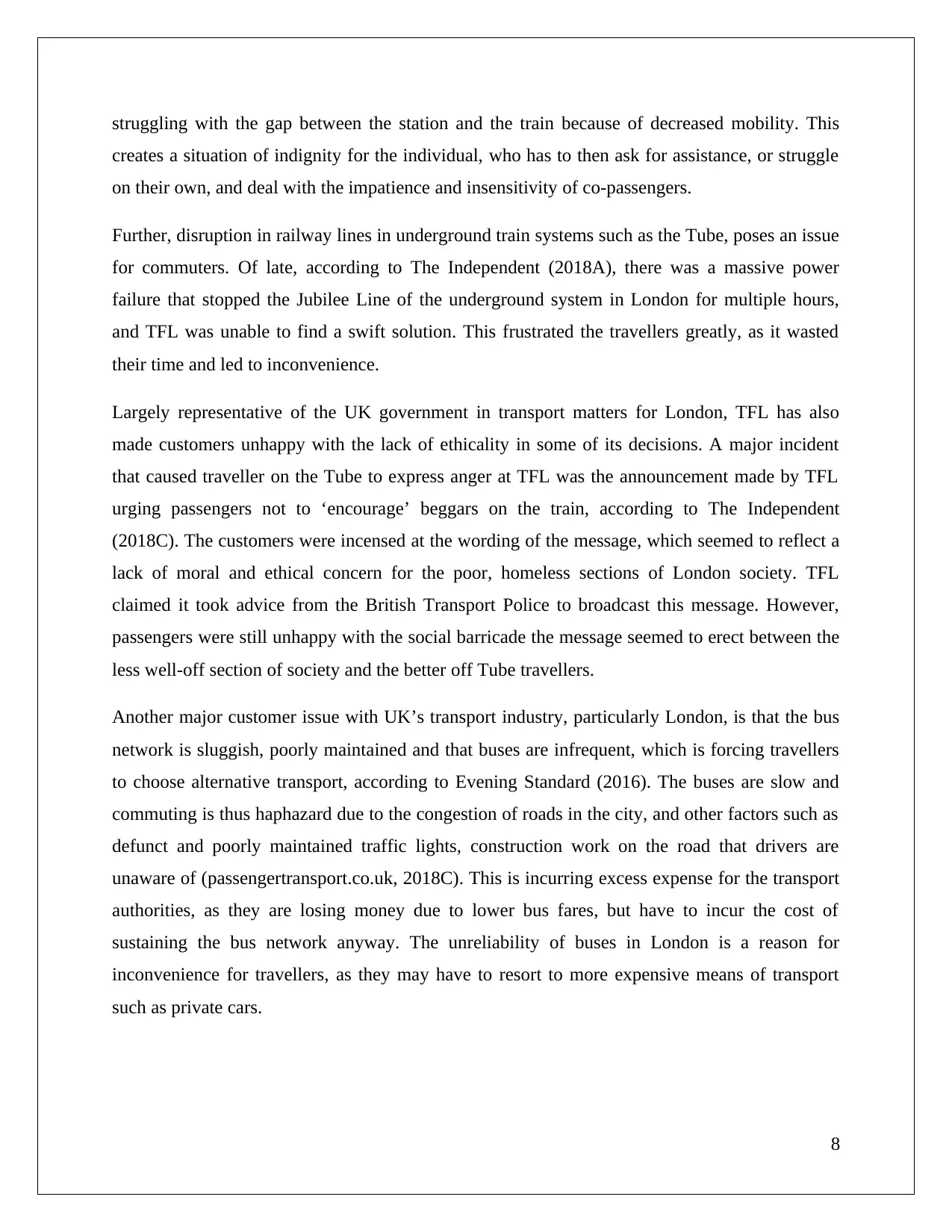
struggling with the gap between the station and the train because of decreased mobility. This
creates a situation of indignity for the individual, who has to then ask for assistance, or struggle
on their own, and deal with the impatience and insensitivity of co-passengers.
Further, disruption in railway lines in underground train systems such as the Tube, poses an issue
for commuters. Of late, according to The Independent (2018A), there was a massive power
failure that stopped the Jubilee Line of the underground system in London for multiple hours,
and TFL was unable to find a swift solution. This frustrated the travellers greatly, as it wasted
their time and led to inconvenience.
Largely representative of the UK government in transport matters for London, TFL has also
made customers unhappy with the lack of ethicality in some of its decisions. A major incident
that caused traveller on the Tube to express anger at TFL was the announcement made by TFL
urging passengers not to ‘encourage’ beggars on the train, according to The Independent
(2018C). The customers were incensed at the wording of the message, which seemed to reflect a
lack of moral and ethical concern for the poor, homeless sections of London society. TFL
claimed it took advice from the British Transport Police to broadcast this message. However,
passengers were still unhappy with the social barricade the message seemed to erect between the
less well-off section of society and the better off Tube travellers.
Another major customer issue with UK’s transport industry, particularly London, is that the bus
network is sluggish, poorly maintained and that buses are infrequent, which is forcing travellers
to choose alternative transport, according to Evening Standard (2016). The buses are slow and
commuting is thus haphazard due to the congestion of roads in the city, and other factors such as
defunct and poorly maintained traffic lights, construction work on the road that drivers are
unaware of (passengertransport.co.uk, 2018C). This is incurring excess expense for the transport
authorities, as they are losing money due to lower bus fares, but have to incur the cost of
sustaining the bus network anyway. The unreliability of buses in London is a reason for
inconvenience for travellers, as they may have to resort to more expensive means of transport
such as private cars.
8
creates a situation of indignity for the individual, who has to then ask for assistance, or struggle
on their own, and deal with the impatience and insensitivity of co-passengers.
Further, disruption in railway lines in underground train systems such as the Tube, poses an issue
for commuters. Of late, according to The Independent (2018A), there was a massive power
failure that stopped the Jubilee Line of the underground system in London for multiple hours,
and TFL was unable to find a swift solution. This frustrated the travellers greatly, as it wasted
their time and led to inconvenience.
Largely representative of the UK government in transport matters for London, TFL has also
made customers unhappy with the lack of ethicality in some of its decisions. A major incident
that caused traveller on the Tube to express anger at TFL was the announcement made by TFL
urging passengers not to ‘encourage’ beggars on the train, according to The Independent
(2018C). The customers were incensed at the wording of the message, which seemed to reflect a
lack of moral and ethical concern for the poor, homeless sections of London society. TFL
claimed it took advice from the British Transport Police to broadcast this message. However,
passengers were still unhappy with the social barricade the message seemed to erect between the
less well-off section of society and the better off Tube travellers.
Another major customer issue with UK’s transport industry, particularly London, is that the bus
network is sluggish, poorly maintained and that buses are infrequent, which is forcing travellers
to choose alternative transport, according to Evening Standard (2016). The buses are slow and
commuting is thus haphazard due to the congestion of roads in the city, and other factors such as
defunct and poorly maintained traffic lights, construction work on the road that drivers are
unaware of (passengertransport.co.uk, 2018C). This is incurring excess expense for the transport
authorities, as they are losing money due to lower bus fares, but have to incur the cost of
sustaining the bus network anyway. The unreliability of buses in London is a reason for
inconvenience for travellers, as they may have to resort to more expensive means of transport
such as private cars.
8
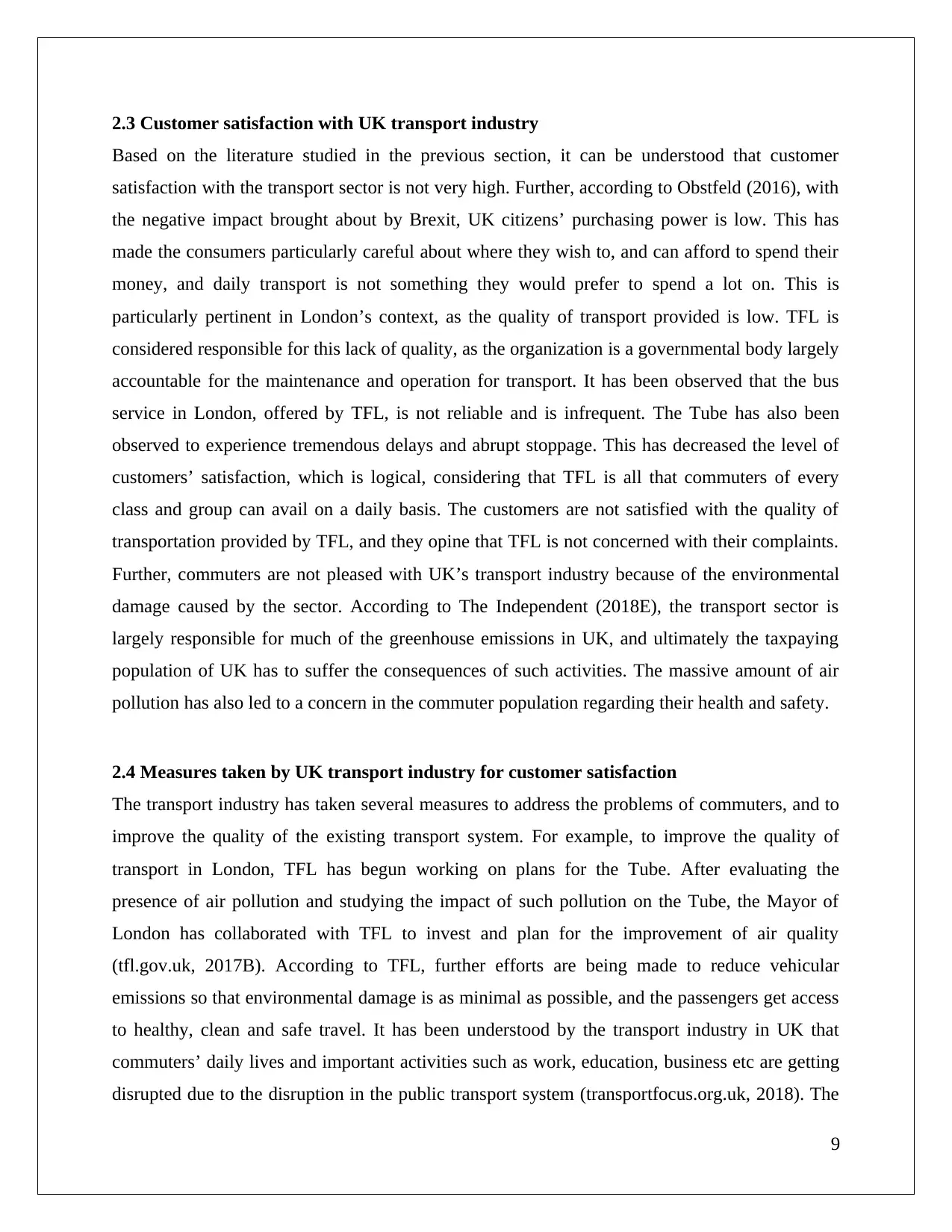
2.3 Customer satisfaction with UK transport industry
Based on the literature studied in the previous section, it can be understood that customer
satisfaction with the transport sector is not very high. Further, according to Obstfeld (2016), with
the negative impact brought about by Brexit, UK citizens’ purchasing power is low. This has
made the consumers particularly careful about where they wish to, and can afford to spend their
money, and daily transport is not something they would prefer to spend a lot on. This is
particularly pertinent in London’s context, as the quality of transport provided is low. TFL is
considered responsible for this lack of quality, as the organization is a governmental body largely
accountable for the maintenance and operation for transport. It has been observed that the bus
service in London, offered by TFL, is not reliable and is infrequent. The Tube has also been
observed to experience tremendous delays and abrupt stoppage. This has decreased the level of
customers’ satisfaction, which is logical, considering that TFL is all that commuters of every
class and group can avail on a daily basis. The customers are not satisfied with the quality of
transportation provided by TFL, and they opine that TFL is not concerned with their complaints.
Further, commuters are not pleased with UK’s transport industry because of the environmental
damage caused by the sector. According to The Independent (2018E), the transport sector is
largely responsible for much of the greenhouse emissions in UK, and ultimately the taxpaying
population of UK has to suffer the consequences of such activities. The massive amount of air
pollution has also led to a concern in the commuter population regarding their health and safety.
2.4 Measures taken by UK transport industry for customer satisfaction
The transport industry has taken several measures to address the problems of commuters, and to
improve the quality of the existing transport system. For example, to improve the quality of
transport in London, TFL has begun working on plans for the Tube. After evaluating the
presence of air pollution and studying the impact of such pollution on the Tube, the Mayor of
London has collaborated with TFL to invest and plan for the improvement of air quality
(tfl.gov.uk, 2017B). According to TFL, further efforts are being made to reduce vehicular
emissions so that environmental damage is as minimal as possible, and the passengers get access
to healthy, clean and safe travel. It has been understood by the transport industry in UK that
commuters’ daily lives and important activities such as work, education, business etc are getting
disrupted due to the disruption in the public transport system (transportfocus.org.uk, 2018). The
9
Based on the literature studied in the previous section, it can be understood that customer
satisfaction with the transport sector is not very high. Further, according to Obstfeld (2016), with
the negative impact brought about by Brexit, UK citizens’ purchasing power is low. This has
made the consumers particularly careful about where they wish to, and can afford to spend their
money, and daily transport is not something they would prefer to spend a lot on. This is
particularly pertinent in London’s context, as the quality of transport provided is low. TFL is
considered responsible for this lack of quality, as the organization is a governmental body largely
accountable for the maintenance and operation for transport. It has been observed that the bus
service in London, offered by TFL, is not reliable and is infrequent. The Tube has also been
observed to experience tremendous delays and abrupt stoppage. This has decreased the level of
customers’ satisfaction, which is logical, considering that TFL is all that commuters of every
class and group can avail on a daily basis. The customers are not satisfied with the quality of
transportation provided by TFL, and they opine that TFL is not concerned with their complaints.
Further, commuters are not pleased with UK’s transport industry because of the environmental
damage caused by the sector. According to The Independent (2018E), the transport sector is
largely responsible for much of the greenhouse emissions in UK, and ultimately the taxpaying
population of UK has to suffer the consequences of such activities. The massive amount of air
pollution has also led to a concern in the commuter population regarding their health and safety.
2.4 Measures taken by UK transport industry for customer satisfaction
The transport industry has taken several measures to address the problems of commuters, and to
improve the quality of the existing transport system. For example, to improve the quality of
transport in London, TFL has begun working on plans for the Tube. After evaluating the
presence of air pollution and studying the impact of such pollution on the Tube, the Mayor of
London has collaborated with TFL to invest and plan for the improvement of air quality
(tfl.gov.uk, 2017B). According to TFL, further efforts are being made to reduce vehicular
emissions so that environmental damage is as minimal as possible, and the passengers get access
to healthy, clean and safe travel. It has been understood by the transport industry in UK that
commuters’ daily lives and important activities such as work, education, business etc are getting
disrupted due to the disruption in the public transport system (transportfocus.org.uk, 2018). The
9
⊘ This is a preview!⊘
Do you want full access?
Subscribe today to unlock all pages.

Trusted by 1+ million students worldwide
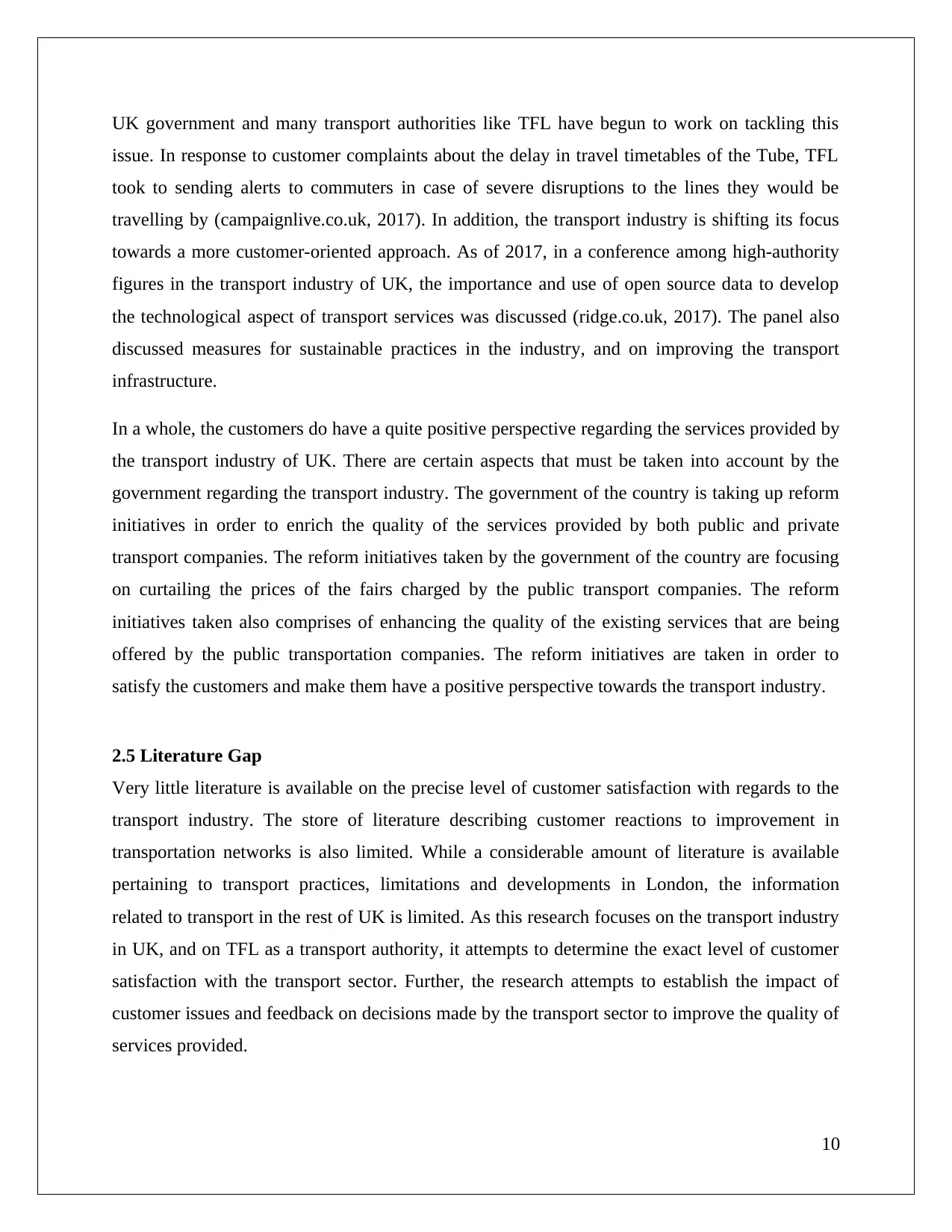
UK government and many transport authorities like TFL have begun to work on tackling this
issue. In response to customer complaints about the delay in travel timetables of the Tube, TFL
took to sending alerts to commuters in case of severe disruptions to the lines they would be
travelling by (campaignlive.co.uk, 2017). In addition, the transport industry is shifting its focus
towards a more customer-oriented approach. As of 2017, in a conference among high-authority
figures in the transport industry of UK, the importance and use of open source data to develop
the technological aspect of transport services was discussed (ridge.co.uk, 2017). The panel also
discussed measures for sustainable practices in the industry, and on improving the transport
infrastructure.
In a whole, the customers do have a quite positive perspective regarding the services provided by
the transport industry of UK. There are certain aspects that must be taken into account by the
government regarding the transport industry. The government of the country is taking up reform
initiatives in order to enrich the quality of the services provided by both public and private
transport companies. The reform initiatives taken by the government of the country are focusing
on curtailing the prices of the fairs charged by the public transport companies. The reform
initiatives taken also comprises of enhancing the quality of the existing services that are being
offered by the public transportation companies. The reform initiatives are taken in order to
satisfy the customers and make them have a positive perspective towards the transport industry.
2.5 Literature Gap
Very little literature is available on the precise level of customer satisfaction with regards to the
transport industry. The store of literature describing customer reactions to improvement in
transportation networks is also limited. While a considerable amount of literature is available
pertaining to transport practices, limitations and developments in London, the information
related to transport in the rest of UK is limited. As this research focuses on the transport industry
in UK, and on TFL as a transport authority, it attempts to determine the exact level of customer
satisfaction with the transport sector. Further, the research attempts to establish the impact of
customer issues and feedback on decisions made by the transport sector to improve the quality of
services provided.
10
issue. In response to customer complaints about the delay in travel timetables of the Tube, TFL
took to sending alerts to commuters in case of severe disruptions to the lines they would be
travelling by (campaignlive.co.uk, 2017). In addition, the transport industry is shifting its focus
towards a more customer-oriented approach. As of 2017, in a conference among high-authority
figures in the transport industry of UK, the importance and use of open source data to develop
the technological aspect of transport services was discussed (ridge.co.uk, 2017). The panel also
discussed measures for sustainable practices in the industry, and on improving the transport
infrastructure.
In a whole, the customers do have a quite positive perspective regarding the services provided by
the transport industry of UK. There are certain aspects that must be taken into account by the
government regarding the transport industry. The government of the country is taking up reform
initiatives in order to enrich the quality of the services provided by both public and private
transport companies. The reform initiatives taken by the government of the country are focusing
on curtailing the prices of the fairs charged by the public transport companies. The reform
initiatives taken also comprises of enhancing the quality of the existing services that are being
offered by the public transportation companies. The reform initiatives are taken in order to
satisfy the customers and make them have a positive perspective towards the transport industry.
2.5 Literature Gap
Very little literature is available on the precise level of customer satisfaction with regards to the
transport industry. The store of literature describing customer reactions to improvement in
transportation networks is also limited. While a considerable amount of literature is available
pertaining to transport practices, limitations and developments in London, the information
related to transport in the rest of UK is limited. As this research focuses on the transport industry
in UK, and on TFL as a transport authority, it attempts to determine the exact level of customer
satisfaction with the transport sector. Further, the research attempts to establish the impact of
customer issues and feedback on decisions made by the transport sector to improve the quality of
services provided.
10
Paraphrase This Document
Need a fresh take? Get an instant paraphrase of this document with our AI Paraphraser
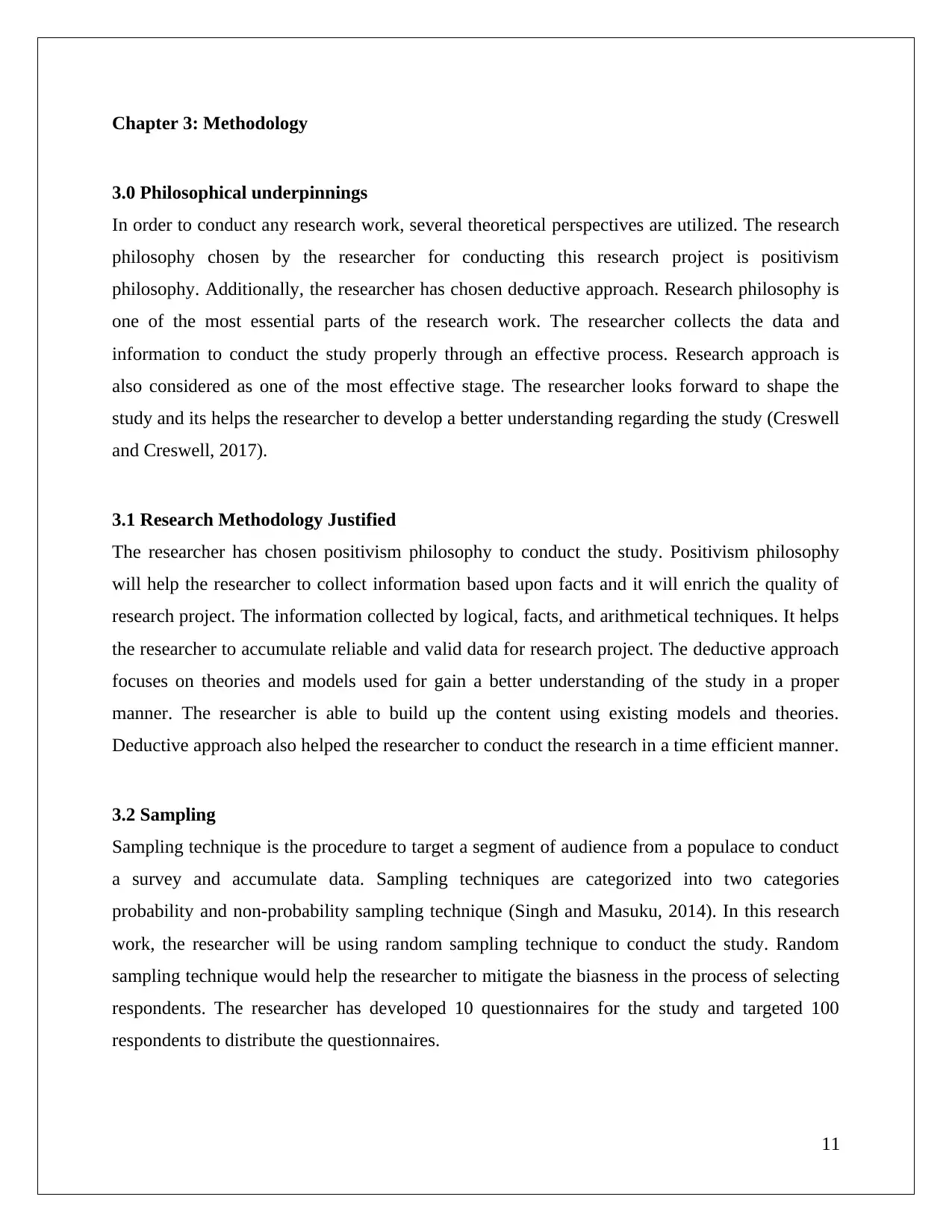
Chapter 3: Methodology
3.0 Philosophical underpinnings
In order to conduct any research work, several theoretical perspectives are utilized. The research
philosophy chosen by the researcher for conducting this research project is positivism
philosophy. Additionally, the researcher has chosen deductive approach. Research philosophy is
one of the most essential parts of the research work. The researcher collects the data and
information to conduct the study properly through an effective process. Research approach is
also considered as one of the most effective stage. The researcher looks forward to shape the
study and its helps the researcher to develop a better understanding regarding the study (Creswell
and Creswell, 2017).
3.1 Research Methodology Justified
The researcher has chosen positivism philosophy to conduct the study. Positivism philosophy
will help the researcher to collect information based upon facts and it will enrich the quality of
research project. The information collected by logical, facts, and arithmetical techniques. It helps
the researcher to accumulate reliable and valid data for research project. The deductive approach
focuses on theories and models used for gain a better understanding of the study in a proper
manner. The researcher is able to build up the content using existing models and theories.
Deductive approach also helped the researcher to conduct the research in a time efficient manner.
3.2 Sampling
Sampling technique is the procedure to target a segment of audience from a populace to conduct
a survey and accumulate data. Sampling techniques are categorized into two categories
probability and non-probability sampling technique (Singh and Masuku, 2014). In this research
work, the researcher will be using random sampling technique to conduct the study. Random
sampling technique would help the researcher to mitigate the biasness in the process of selecting
respondents. The researcher has developed 10 questionnaires for the study and targeted 100
respondents to distribute the questionnaires.
11
3.0 Philosophical underpinnings
In order to conduct any research work, several theoretical perspectives are utilized. The research
philosophy chosen by the researcher for conducting this research project is positivism
philosophy. Additionally, the researcher has chosen deductive approach. Research philosophy is
one of the most essential parts of the research work. The researcher collects the data and
information to conduct the study properly through an effective process. Research approach is
also considered as one of the most effective stage. The researcher looks forward to shape the
study and its helps the researcher to develop a better understanding regarding the study (Creswell
and Creswell, 2017).
3.1 Research Methodology Justified
The researcher has chosen positivism philosophy to conduct the study. Positivism philosophy
will help the researcher to collect information based upon facts and it will enrich the quality of
research project. The information collected by logical, facts, and arithmetical techniques. It helps
the researcher to accumulate reliable and valid data for research project. The deductive approach
focuses on theories and models used for gain a better understanding of the study in a proper
manner. The researcher is able to build up the content using existing models and theories.
Deductive approach also helped the researcher to conduct the research in a time efficient manner.
3.2 Sampling
Sampling technique is the procedure to target a segment of audience from a populace to conduct
a survey and accumulate data. Sampling techniques are categorized into two categories
probability and non-probability sampling technique (Singh and Masuku, 2014). In this research
work, the researcher will be using random sampling technique to conduct the study. Random
sampling technique would help the researcher to mitigate the biasness in the process of selecting
respondents. The researcher has developed 10 questionnaires for the study and targeted 100
respondents to distribute the questionnaires.
11
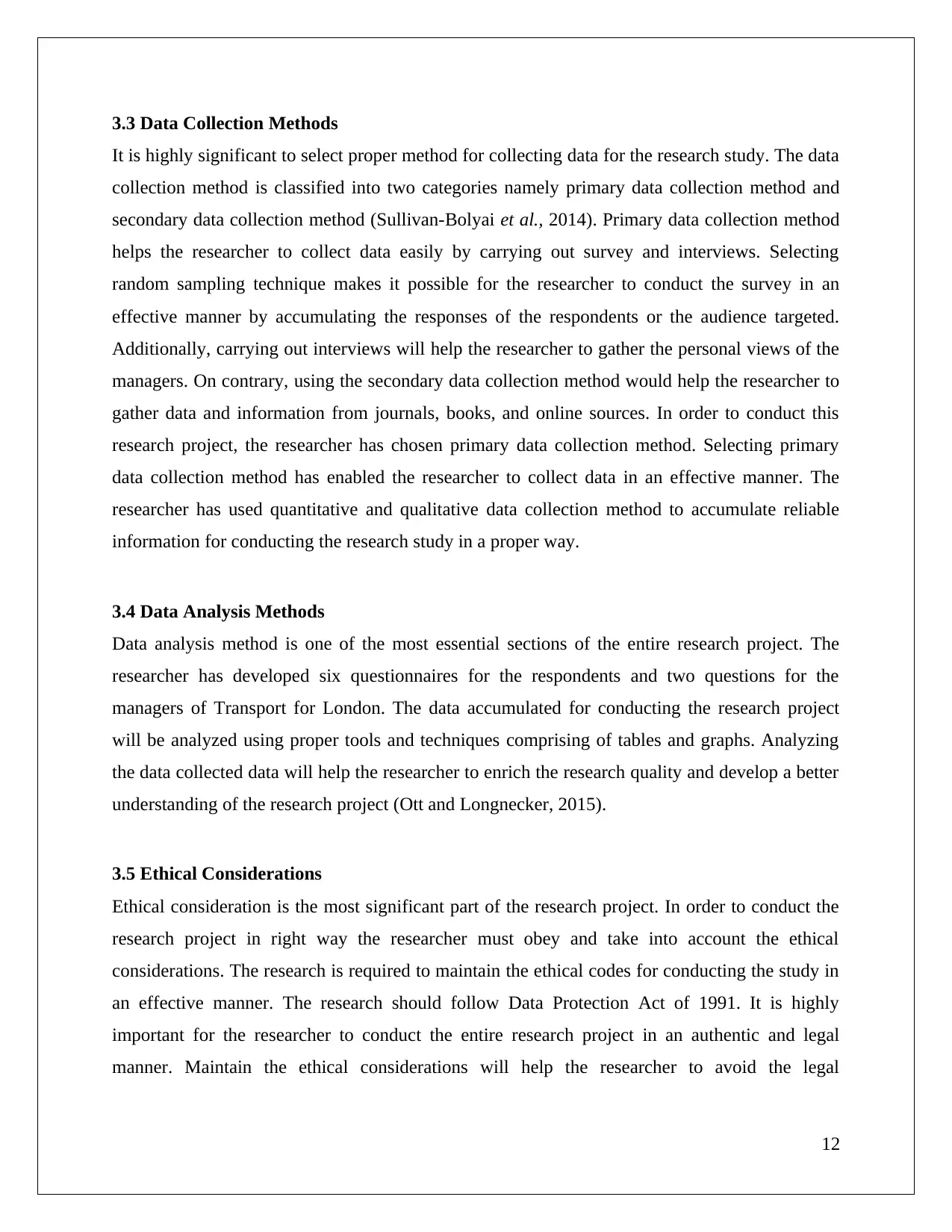
3.3 Data Collection Methods
It is highly significant to select proper method for collecting data for the research study. The data
collection method is classified into two categories namely primary data collection method and
secondary data collection method (Sullivan-Bolyai et al., 2014). Primary data collection method
helps the researcher to collect data easily by carrying out survey and interviews. Selecting
random sampling technique makes it possible for the researcher to conduct the survey in an
effective manner by accumulating the responses of the respondents or the audience targeted.
Additionally, carrying out interviews will help the researcher to gather the personal views of the
managers. On contrary, using the secondary data collection method would help the researcher to
gather data and information from journals, books, and online sources. In order to conduct this
research project, the researcher has chosen primary data collection method. Selecting primary
data collection method has enabled the researcher to collect data in an effective manner. The
researcher has used quantitative and qualitative data collection method to accumulate reliable
information for conducting the research study in a proper way.
3.4 Data Analysis Methods
Data analysis method is one of the most essential sections of the entire research project. The
researcher has developed six questionnaires for the respondents and two questions for the
managers of Transport for London. The data accumulated for conducting the research project
will be analyzed using proper tools and techniques comprising of tables and graphs. Analyzing
the data collected data will help the researcher to enrich the research quality and develop a better
understanding of the research project (Ott and Longnecker, 2015).
3.5 Ethical Considerations
Ethical consideration is the most significant part of the research project. In order to conduct the
research project in right way the researcher must obey and take into account the ethical
considerations. The research is required to maintain the ethical codes for conducting the study in
an effective manner. The research should follow Data Protection Act of 1991. It is highly
important for the researcher to conduct the entire research project in an authentic and legal
manner. Maintain the ethical considerations will help the researcher to avoid the legal
12
It is highly significant to select proper method for collecting data for the research study. The data
collection method is classified into two categories namely primary data collection method and
secondary data collection method (Sullivan-Bolyai et al., 2014). Primary data collection method
helps the researcher to collect data easily by carrying out survey and interviews. Selecting
random sampling technique makes it possible for the researcher to conduct the survey in an
effective manner by accumulating the responses of the respondents or the audience targeted.
Additionally, carrying out interviews will help the researcher to gather the personal views of the
managers. On contrary, using the secondary data collection method would help the researcher to
gather data and information from journals, books, and online sources. In order to conduct this
research project, the researcher has chosen primary data collection method. Selecting primary
data collection method has enabled the researcher to collect data in an effective manner. The
researcher has used quantitative and qualitative data collection method to accumulate reliable
information for conducting the research study in a proper way.
3.4 Data Analysis Methods
Data analysis method is one of the most essential sections of the entire research project. The
researcher has developed six questionnaires for the respondents and two questions for the
managers of Transport for London. The data accumulated for conducting the research project
will be analyzed using proper tools and techniques comprising of tables and graphs. Analyzing
the data collected data will help the researcher to enrich the research quality and develop a better
understanding of the research project (Ott and Longnecker, 2015).
3.5 Ethical Considerations
Ethical consideration is the most significant part of the research project. In order to conduct the
research project in right way the researcher must obey and take into account the ethical
considerations. The research is required to maintain the ethical codes for conducting the study in
an effective manner. The research should follow Data Protection Act of 1991. It is highly
important for the researcher to conduct the entire research project in an authentic and legal
manner. Maintain the ethical considerations will help the researcher to avoid the legal
12
⊘ This is a preview!⊘
Do you want full access?
Subscribe today to unlock all pages.

Trusted by 1+ million students worldwide
1 out of 26
Related Documents
Your All-in-One AI-Powered Toolkit for Academic Success.
+13062052269
info@desklib.com
Available 24*7 on WhatsApp / Email
![[object Object]](/_next/static/media/star-bottom.7253800d.svg)
Unlock your academic potential
Copyright © 2020–2025 A2Z Services. All Rights Reserved. Developed and managed by ZUCOL.




